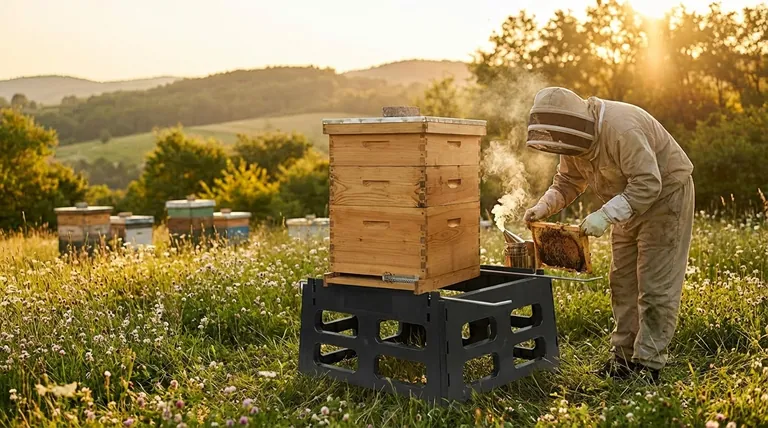When supporting a bee hive, the primary consideration is to use a stable and secure platform that elevates the hive off the ground. This foundation is not merely for support; it is a critical component that directly impacts the colony's health, defensibility against pests, and your ability to manage it effectively.
A hive stand is the first line of defense for your colony. Its function goes beyond simple support, providing crucial protection from ground moisture and pests while creating an ergonomic working height for the beekeeper.

The Core Principles of Hive Support
The decision of how to support your hive should be guided by three fundamental principles that contribute to a successful apiary. These principles apply whether you use simple blocks or a purpose-built stand.
Principle 1: Elevation for Colony Health
Keeping the hive off the ground is non-negotiable for maintaining a healthy colony.
Elevation provides critical distance from ground moisture, preventing the bottom board from rotting and improving ventilation. This helps the bees regulate temperature and humidity more efficiently.
It also serves as a primary defense against crawling pests like ants and larger predators such as skunks, which are less likely to disturb a raised hive.
Principle 2: Stability for Structural Security
A mature hive, full of honey, brood, and bees, can weigh hundreds of pounds.
The support structure must be perfectly level and placed on firm, compacted ground to prevent tipping. An unstable hive is a significant danger to both the colony and the beekeeper.
The entire stack of hive components—from the bottom board and brood chamber to the honey supers and lid—relies on this stable foundation.
Principle 3: Accessibility for the Beekeeper
Proper hive height is crucial for sustainable beekeeping.
A stand that raises the hive to a comfortable working height (typically 12-18 inches) saves you from constant bending and straining your back during inspections. This makes management easier, faster, and more enjoyable.
Understanding the Trade-offs
Different support options offer varying levels of cost, convenience, and durability. Understanding their trade-offs is key to making an informed choice.
Cost vs. Durability
Cinder blocks are an inexpensive and widely available option that will not rot. However, they can be heavy and may settle into soft ground over time.
Wooden stands can be built to custom specifications but require weather-resistant wood or treatment to prevent rot. Commercial metal stands offer the best longevity but come at a higher initial cost.
Simplicity vs. Integrated Features
A pair of cinder blocks is the simplest solution, providing basic elevation and stability.
Many commercial hive stands, however, include valuable features like built-in frame holders for inspections or feet that can be placed in cups of oil to create a barrier against ants.
Height and Ergonomics
A very low stand may not offer sufficient protection from moisture or pests.
Conversely, a stand that is too high can make lifting heavy honey supers—which can weigh over 50 pounds each—a difficult and potentially unsafe task. The ideal height balances protection with ease of lifting.
Making the Right Choice for Your Goal
Your choice of hive support should align with your budget, physical needs, and overall management philosophy.
- If your primary focus is budget and simplicity: Two level cinder blocks provide a stable, rot-proof, and highly effective foundation.
- If your primary focus is ease of management and ergonomics: A commercial hive stand at waist height with built-in frame rests is the ideal choice.
- If your primary focus is pest control: Select a stand with feet that can be placed in oil-filled containers to create a formidable barrier against crawling insects.
Ultimately, a proper foundation is the first and most critical step in building a healthy, productive, and manageable honey bee colony.
Summary Table:
| Principle | Key Benefit | Key Consideration |
|---|---|---|
| Elevation | Protects from ground moisture & pests | Ideal height: 12-18 inches |
| Stability | Prevents tipping of heavy hives | Must be perfectly level on firm ground |
| Accessibility | Saves beekeeper's back during inspections | Balances protection with ease of lifting supers |
Ready to build a stable foundation for your apiary? The right hive stand is crucial for colony health and your efficiency. HONESTBEE supplies durable, ergonomic beekeeping equipment and hive stands designed for the needs of commercial apiaries and distributors. Let us help you choose the perfect support system for your operation.
Contact HONESTBEE today for wholesale pricing and expert advice!
Visual Guide

Related Products
- Plastic Bee Hive Stand for Beekeeping
- Metal Hive Feet Bee Hive Stand for Ant Protection
- Professional Ant-Proof Beehive Stand with Integrated Moat for Beekeeping
- Professional Engraved Round Hive Number Tags for Beekeeping
- Metal Bee Hive Stand Bee Box Stand for Beekeeping
People Also Ask
- How do bees regulate the temperature of their hive during the summer? Discover Their Natural Cooling System
- What are the main differences between Langstroth and Top Bar Hive designs? Choose the Right Hive for Your Beekeeping Goals
- What are the advantages of a second hive if the queen is killed? The Ultimate Insurance Policy for Your Apiary
- How do plastic bee hives compare to wooden hives in handling? Reduce Strain & Boost Efficiency
- How does the longevity of plastic bee hives compare to wooden hives? Discover the Durable Choice



















